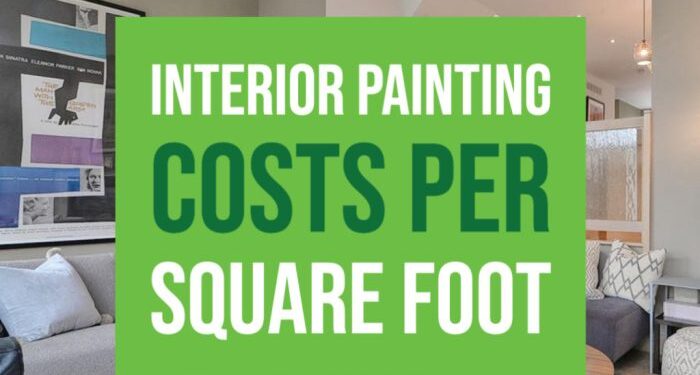Delve into the world of interior painting cost per square foot as we uncover the key factors influencing pricing, average cost ranges, calculation methods, and tips to save on your next project. Get ready to paint a vivid picture of what to expect when it comes to painting your interiors.
Factors Affecting Interior Painting Cost
When determining the cost of interior painting per square foot, several factors come into play that can significantly impact the overall pricing. Understanding these factors is crucial for homeowners and businesses looking to paint their interiors.Quality of Paint
The quality of paint used in the interior painting project can greatly affect the cost per square foot. High-quality paints tend to be more expensive but offer better coverage, durability, and overall finish. On the other hand, lower-quality paints may require more coats to achieve the desired result, leading to increased labor costs and potentially higher total expenses.Labor Costs
Labor costs play a significant role in determining the overall cost of interior painting. Factors such as the skill level of the painters, the number of labor hours required, and the size of the painting crew can all impact pricing. Experienced painters may charge higher rates but can deliver a more professional and efficient job, ultimately affecting the cost per square foot.Condition of the Walls
The condition of the walls being painted can also influence the cost of the project. Walls that require extensive preparation work, such as patching holes, repairing cracks, or removing old wallpaper, can increase the labor hours needed and, in turn, raise the cost per square foot. Smooth, well-maintained walls, on the other hand, may require less preparation and lead to lower overall expenses.Average Cost Range for Interior Painting
When it comes to the average cost range for interior painting, it can vary depending on different regions and the complexity of the project. Factors such as the size of the area to be painted, the quality of paint used, and the level of preparation needed can all impact the overall cost.Cost Range in Different Regions
In general, the average cost per square foot for interior painting typically ranges from $2 to $6. However, prices can vary significantly based on the location. For example, urban areas or regions with higher living costs may have higher painting rates compared to rural areas. It's essential to research local pricing trends to get a more accurate estimate for your specific location.Variations Based on Project Complexity
The complexity of the painting project can also affect the cost. Projects that require extensive surface preparation, such as repairing drywall or removing wallpaper, may incur additional charges. Similarly, intricate designs or detailed trim work can increase the overall cost of the painting job.DIY vs. Professional Painting
While some homeowners opt to save money by painting their interiors themselves, hiring professional painters can offer several advantages. DIY painting may cost less upfront, but without the expertise and tools of professionals, the quality of the finish may not be as high. Professional painters can ensure a smooth, even coat of paint and provide a more durable and long-lasting finish. The cost of hiring professionals may be higher, but the quality and convenience they offer can often justify the expense.Cost Calculation Methods
When it comes to calculating the total cost of interior painting per square foot, there are several common methods used by professionals. These methods take into account various factors such as room size, paint type, labor costs, and other variables that can impact the overall cost of the project.To calculate the cost of interior painting per square foot, you can follow these steps:Step-by-Step Guide
- Measure the total square footage of the area to be painted. This includes walls, ceilings, and any other surfaces that will be painted.
- Determine the type of paint you will be using. Different paint types have varying costs per gallon, so this will impact the overall cost.
- Consider any additional materials needed for the project, such as primer, caulk, or tape. These items will add to the total cost.
- Factor in the labor costs, which can vary depending on the complexity of the job and the experience level of the painters.
- Calculate any additional fees or charges that may be included in the final cost, such as travel expenses, equipment rentals, or disposal fees for old paint and materials.















